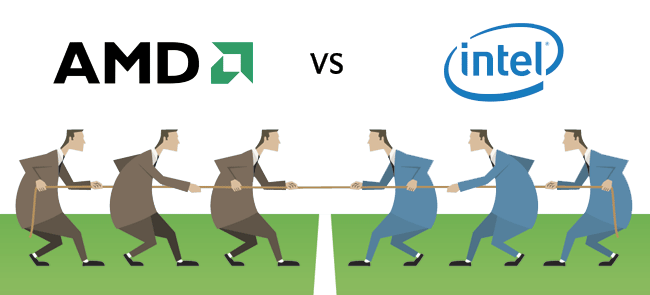AMD Dual-Core Opteron VS Dual-Core Xeon

The launch of the Athlon MP
It was a bittersweet victory for AMD just under two years ago. AMD was able to deliver performance that was significantly faster than Intel’s brand new Xeon, but despite performance leadership, the CPU never really took off. By the end of the Athlon MP’s life, Intel’s performance had improved significantly to the point where AMD no longer held a performance advantage. Then, to no one’s surprise, AMD retook their lead in the processor market by releasing their Dual-Core Opteron systems which far exceeded Intel’s top of the line Xeons available on the market by leaps and bounds.
It’s high time for Intel to find a proper response
As the competition is taking the wind out of Intel’s server CPU sails, what’s the answer? A Xeon based on the Core architecture: Woodcrest. The Intel Xeon 5160, (Intel’s Top Dual-Core Xeon.) Will Intel best the current performance champion AMD in server-wide performance?
Dual-Core vs. Dual-Processor: Best Dedicated Enterprise Solution?
Dual-processor setups were the only way to go for many years if you were in need of serious computing power. Architects, engineers, graphic artists, and even gamers desiring the ultimate in power could utilize a dual processor setup. In such a setup, each core is able to perform computational tasks so long as the application supports two processors. These processors communicate with each other through a bus on the motherboard in their sharing of loads. Intel and AMD have both realized the performance limiter in any dual-processor setup was the communication lag between the processors. Each company has sought to eliminate that lag by incorporating another processor on the same die, thus eliminating 99% of the lag time in communication.
Intel Dual-Core Xeon: Intel’s Answer
- Intel Smart Memory Access – The enhanced data prefetch mechanism reduces the idling time of the processor execution pipeline.
- Intel Advanced Smart Cache – Intellectual L2 cache is shared between the two processor cores depending on their load at a given moment. Moreover, the shared L2 cache speeds up data transfer rates between the cores and reduces the front side bus workload, because no data needs to be transferred via the system memory anymore.
- Intel Advanced Media Boost – The processor works faster with SSE3 instructions because it can perform the binary operations with 128-bit SSE registers within one clock cycle.
- Intel Virtualization Technology (Intel VT) – This virtualization technology allows modeling the work of several virtual platforms on a single hardware system.
AMD Dual-Core Opteron: AMD’s Answer
- Integrated DDR Memory Controller – Each of the two processor cores can process four instructions per clock cycle.
- AMD HyperTransport Technology – HyperTransport technology is a high-speed, low-latency, point-to-point link designed to increase the communication speed between integrated circuits in computers, servers, embedded systems, and networking and telecommunications equipment by up to 48 times faster than some existing technologies.
- AMD Virtualization – By using VMware virtual infrastructure software on AMD Opteron processor-based servers, enterprises can significantly increase the number of virtual machines on a single physical system.
L2 Cache: Is there enough?
The amount of cache on a CPU is important to performance. The Opteron 2xx series has up to 2x128k L1 cache which towers over Intel’s 2x32k. While this does show AMD dominating L1 cache Intel comes back strong offering an outstanding 4 MB dedicated L2 cache.This means that the L2 cache is shared by the two cores. This is more than double AMD’s 2x1MB L2 offered on their Opteron 285 and also are non-unified, in that each CPU core has its own L2 cache. If the same data is required for multiple cores the data need only be stored once, while on a non-unified L2 cache a copy is shared on each core’s cache.
Hosting Solutions: Dedicated or Shared
Dual-core processors work best when software can run in parallel on them. So-called “multithreaded applications” benefit from an additional CPU core because subroutines can be allocated to different arithmetic and logic units. Administering the threads carries an overhead, though, which means that dual-core processors are never exactly twice as fast as their single core counterparts. This being said, Intel still outperforms in most multithreaded applications on multiple occasions as shown below.
Database Performance (Linux)
| Opteron 275 | Opteron 280 | Opteron 280 vs. Opteron 275 | Intel Xeon 5160 3GHz | |
|---|---|---|---|---|
| MySQL – Dual-core | 749 | 805 | 7% | 996 |
| MySQL – Quad-core | 590 | 622 | 5% | 904 |
| PostgreSQL | 490 | 524 | 7% | 673 |
Benchmarked and tested by Anandtech.
Web Server Performance
| Opteron 275 | Opteron 280 | Opteron 280 vs. Opteron 275 | Intel Xeon 5160 3GHz | |
|---|---|---|---|---|
| Jsp – Peak | 144 | 154 | 7% | 230 |
| AMP – Peak | 984 | 1042 | 6% | 1828 |
“Jsp” gives you the Java Server Page performance, AMP stands for Apache/MySQL/PHP.
Benchmarked and tested by Anandtech.
Conclusion: Performance Analysis?
The Intel Xeon 5160, will simply be the most powerful server CPU this year. Even a 2.6 GHz Woodcrest will outperform the current Opteron 285 with a 5 to 55% margin, nothing short of impressive. The new Xeon is however not invincible: the Opteron can still give some serious resistance when running certain programs. Intel will still have to convince some software vendors to port to SSE if it wants Woodcrest to be the completely superior CPU. The advantage in MySQL is also rather small. Intel’s newest Xeon has taken back the performance crown.
